Apple's iPad - The AnandTech Review
by Anand Lal Shimpi, Brian Klug & Vivek Gowri on April 7, 2010 9:39 PM EST- Posted in
- Smartphones
- Mac
- Apple
- iPad
- Mobile
Reading Rainbow
The first time you launch the App Store, it prompts you whether you'd like to install the iBooks application. It's puzzling that iBooks isn't installed by default - perhaps it wasn't finished by the time Apple started flashing EEPROMs for production. Whatever the case, Apple definitely wants you to install their books and reading application immediately upon launch. Until something better comes out, there admittedly isn't any reason you shouldn't.
iBooks is fairly minimalist in its initial presentation, there's no organization or categorization to speak of, just virtual shelves that your "books" sit on. It'd be nice to have some organization here, lest the same kind of icon hell happen with books instead of applications now.
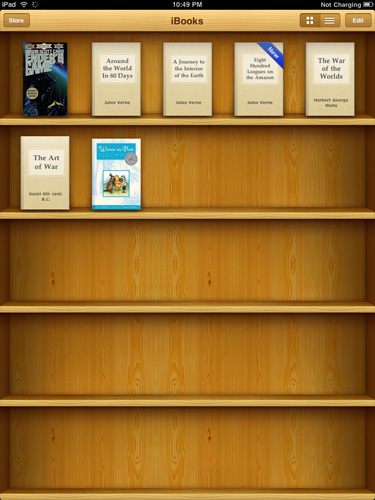
I totally put my real books in bookshelves with their front covers facing out, too
Inside, Apple has crafted a virtual book layout complete with some flashy 3D page turning animations. There's even transparency on the backsides of pages when viewing them in portrait mode.
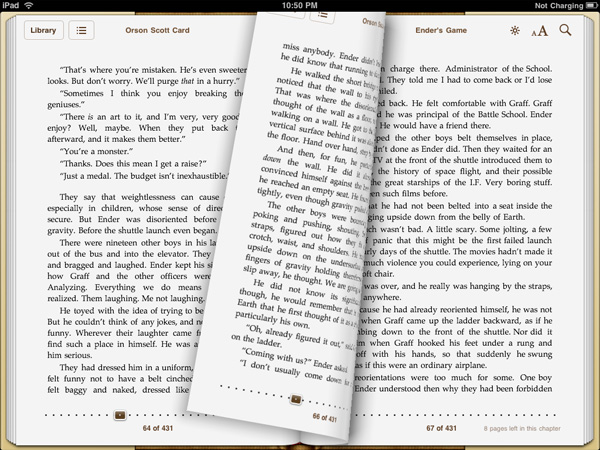
Ooh look at the flashy page turn animations
Controls for brightness, text size, and search adorn the top corner, and a slider at the bottom lets you quickly scrub through the book. You can't flick pages quite as fast as you can in a real book, but it's decently fast. Tapping on words in the body of the text brings up the normal copy dialog, but there's also dictionary, bookmark, and search. Bookmarking puts a faux highlighter mark on the selection, and makes a bookmark. Dictionary pops up an OS X dictionary widget-like popover with the word's definition. Search, well, searches.
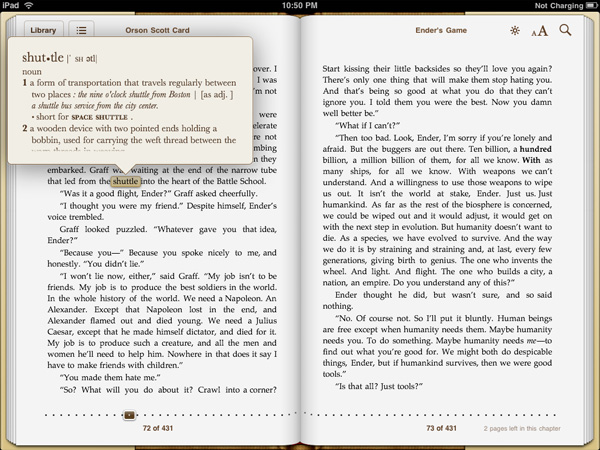
I regularly ride my space shuttle to Boston, er, what?
The store itself is relatively limited in scope this far - searching through it for many of the classics I love revealed that they weren't yet included. Free books from Project GutenbergOrganization and appearance is just like the App Store, except with books. That means ratings, categories and featured are all there as well. The reviews themselves are still getting fleshed out; it's a bit unnerving to see one star ratings on timeless classics, but all of that same goodness from the App Store is here in the book store. Nominal price seems to be somewhere around $9.99, though prices are bracketed by the occasional $14.99 or $8.99 book.
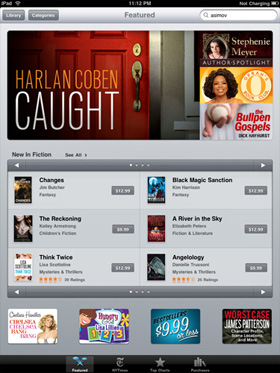 |
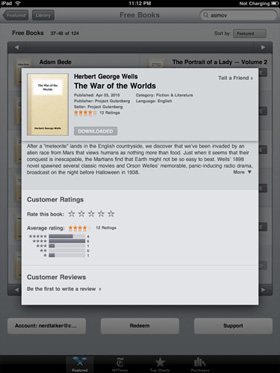 |
Books sync back to iTunes, but you can't open them. In addition, it's apparent that the book store is segmented from the App store somehow, as you cannot buy books in iTunes from the iTunes Store and load them on the iPad. The iBook application fully supports the ePub format for books as well.
Other Reading Apps
If reading through iBooks isn't your thing, there are other ways of consuming print media on the iPad, but for those, you'll have to go install an app.
Case in point are PDFs; if left to using the OS' PDF reader, your only options are either browsing online or as email attachments, and both of those get old fast. Though the default reader works, its typical Apple minimalist style leaves out just about everything that makes modern PDF readers, modern. You can view the document; that's it. If you're serious about reading PDFs, one of the best applications for the iPhone was GoodReader, and its developers launched an iPad compatible version day one. Layout is essentially the same as it was on the iPhone version, just larger and more readable.
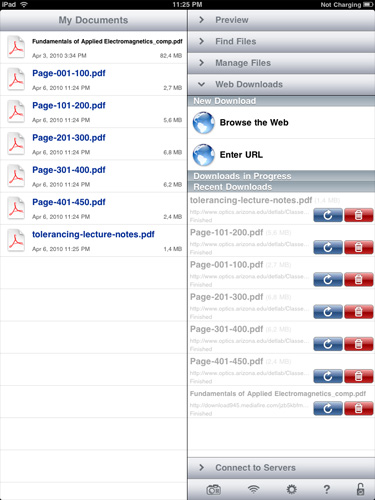
PDFs and Text files can either downloaded from the web or email, or loaded over WiFi, WebDAV, Google Docs, Dropbox or FTP, and are then stored locally. In addition to being noticeably faster than the OS' PDF viewer, there's also an interface complete with bookmarks, search, view, reflow, and even auto scrolling. If you've already got an expansive library of books or notes in PDF form, this is the optimal way to view them for now.
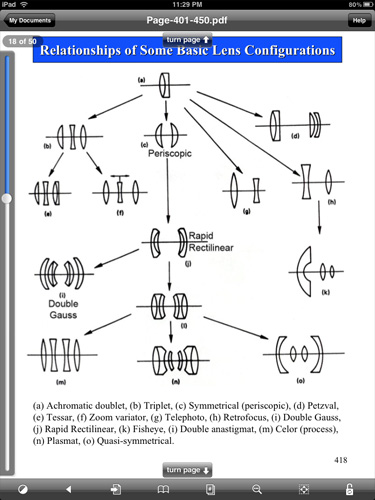
For students, the majority of material is passed down in PDF form; it's nice to finally see a polished document reader for one of the most veteran document formats. In practice, this is the way that iPhone OS' PDF reader should work out of the box.
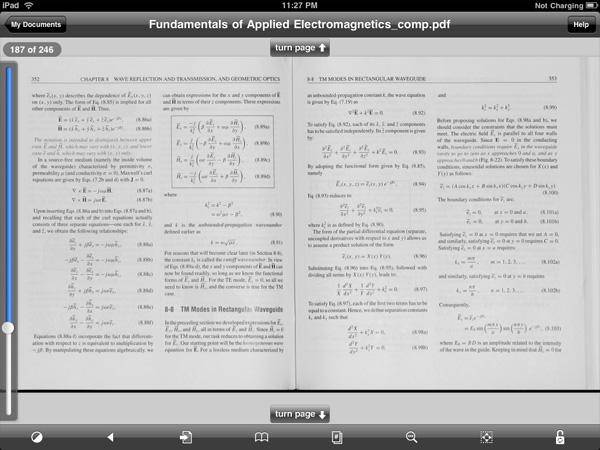
Of course, there's also the Kindle app which has adopted a similar style to the iBooks app, complete with animated 3D page turns, a grid layout, and the like. It's a great utility if you're already invested in a virtual library of Kindle books. If you haven't seen it by now, there's also the Marvel comic book reader. The iPad's usefulness as a book and print media reader is still evolving, but the primary players are still News.
Media - News
The iPad has become something of a messiah for mainstream print media hoping to finally offer a brave new business model for media consumption. Basically all the major press has their own dedicated newsreader or news-zine application, and this is simultaneously great, and destructive for the platform. On one hand, the iPad is a unique way to consume media tailored to a common device form factor - it's no coincidence that the thing is roughly the size of a magazine. On the other, each of the experiences media venues offer is radically different. One thing is for certain, it's unclear what users will ultimately prefer - tailored experiences delivered through venue-specific applications, or simply getting the same content online.
Of course, there are strings attached in the form of subscriptions. There are two ends of the spectrum here - one offers free media, the other is a subscription or issue based model for all your reading habits. Applications like NPR, Bloomberg, BBC News, NYT, Reuters, USA Today and the Associated Press all offer AD-subsidized or essentially free media consumption. There's the occasional inline or application launch advertisement, but most of it is relatively unobtrusive.
Wall Street Journal, Time, GQ and others instead only offer in-application subscription or purchase. Will people consume media and tolerate the occasional AD, or is subscription the only way to monetize the iPad? The subscription model battle that some media venues are hoping will save their publications will likely be fought partly on the iPad and other converged distribution platforms.
Utility, Entertainment and Social Media
At least thus far, it seems as though a lot of applications have taken a nod from Apple's Mail application design - a quarter width tab at left with information, and a dominant panel for more focus at right. It's obvious that developers used to working on the relatively cramped layout of the iPhone still haven't found the optimal use layout for the iPad's larger screen, but this two panel approach nearly mitigates lack of multitasking for some use scenarios.
The best of example of which is side by side Twitter with web browsing. If any of you are like me, you likely browse with a Twitter client open on one side of the screen and a browser on the other - offering you a glance at what's going on alongside the program in which to view it. This is exactly what TweetBrowser offers, and I think it's the kind of new use scenario that will distinguish the iPad from its smartphone brethren. In time, we'll likely see more efficient use of screen real-estate in other applications, which TweetBrowser does already.

TweetBrowser - Best of all, it's free
Another awesome use of the newfound real-estate is in TweetDeck for iPad. Landscape mode offers a view of all your default tabs and searches, while portrait mode lets uses the vacant space at top to display tweets in detail view, or a browser for links.















108 Comments
View All Comments
TGressus - Thursday, April 8, 2010 - link
"I don't think anything anyone can write can convince you"That's a tough sell right there :( Nothing against your post.
This is the challenge all tablets have faced so far. That said, if anyone has the ability to succeed in this form factor it's the iCult.
Mike1111 - Thursday, April 8, 2010 - link
"While I realize that Atom hasn't been suited for such an application until now, there's no reason Apple should've picked the A4 over Moorestown. "I really think it was the right decision for Apple to go with ARM for the iPad, and that it's the right decision to stick with ARM for at least the next few years.
(1) Mobile version of Moorestown is not available yet, the netbook one draws too much power
(2) Apple has to use ARM in it's iPhone and iPod touch for the next few years, so for cross-device OS, app and SoC compatibility and development ARM was the right choice for the iPad (e.g. if Apple makes safari use the hardware better on the iPad, the iPhone and iPod touch will directly profit from it too)
(3) Moorestown would have been more expensive
(4) With ARM Apple can control and modify the CPU design as needed, they have total control. And Apple likes that.
(5a) There is a clear upgrade path for ARM with the Cortex-A9 and a multi-core version of it.
(5b) The A4 is already fast enough for most people and most iPad tasks (how many reviews mention that the iPad is unpleasantly slow, even for the average consumer?)
It's a real possibility that an iPad with a more optimized OS and safari, a better utilized (and more programmable) GPU (like the SGX545 with OpenCL etc.) and a dual-core Cortex-A9 @1.x GHz will improve the browsing performance beyond that of a netbook. And IF APPLE SAW THE NEED FOR IT (but I don't think they do), it could happen as early as next year (other ARM SoCs like Tegra2, OMAP4 and the dual-core Snapdragon will be available by then with comparable specs, so Apple should be able to pull it off too). Intel's Atom will still be a more power consuming, more expensive and way bigger multi-chip system early next year. And beyond that are ARM quad-core CPUs and dual-core GPUs...
It will take Atom at least 4 years to overtake ARM, in the areas that count for dedicated smartphones/slates/tablets, if at all. At some point, real life browsing will just be fast enough on an ARM slate and Intel netbook, so that 99% don't care about browsing speed as a feature anymore (like it will happen with video thanks to all these powerful but small dedicated decoders/encoders like IMG's VXD/VXE).
softdrinkviking - Thursday, April 8, 2010 - link
are you saying that there is no clear upgrade path for intel's moorstown line?and that apple has complete control over the future of ARM?
i didn't know they had already gone that far.
i seem to remember apple fumbling out of the power series of CPUs and crawling into into intel's arms when they realized it was the way to go.
there is nothing to prevent apple from switching to moorstown in a couple of generations, and they have proven that they are willing to make those kind of changes when the situation demands it.
Mike1111 - Friday, April 9, 2010 - link
"are you saying that there is no clear upgrade path for intel's moorstown line?"Of course not. I'm just saying that even if you think the ARM Cortex-A8 used in the iPad is not powerful enough, that there are clear CPU upgrades coming your way for years to come (higher frequencies, Cortex-A9, dual-core Cortex-A9, quad-core Cortex-A9). It's not like Apple is using a quad-core Cortex-A9 @ 4 GHz in 22nm right now, with no better ARM architecture on the horizon and standard lithography reaching a dead end...
"and that apple has complete control over the future of ARM? i didn't know they had already gone that far."
Sorry, what I meant was that Apple has complete control over how they implement the ARMv7 architecture in a chip (since Apple has most likely an architecture license like Qualcomm).
"there is nothing to prevent apple from switching to moorstown in a couple of generations, and they have proven that they are willing to make those kind of changes when the situation demands it."
I agree that Apple can and most likely will switch to Intel if their chips are clearly superior in all the ways that matter for a mobile product. I just think that's at least 4-5 years out for retail devices so there's no point in talking about how Apple should have used Moorestown for this year's iPad... or any iPad for that matter. I don't even think that Moorestown's successor will be ready (Medfield). Maybe Medfield's successor's successor in 22nm will be clearly superior (although parity could be reached a generation earlier). We'll see.
MadAd - Thursday, April 8, 2010 - link
Its huge. Way too big for car centre consoles. If they cut it in half, so its mid way between that and an Iphone then I would definitely want to upgrade my existing car PC.Its got all the right airs and graces to be a super satnav/speedcam/music/incar wifi unit, just need to cut the size and sell it with some kind of some kind of quick release device for power and cabling (or ill fabricate one) and its a winner.
teng029 - Thursday, April 8, 2010 - link
"Companies like Crestron and AMX supply ridiculously poor touch screen interfaces to their very expensive home automation installations."How exactly did you come to this conclusion? Have you extensively either used or program a control system touch panel?
Anand Lal Shimpi - Thursday, April 8, 2010 - link
Used, but not programmed. Those touchscreen controllers are just not in the same league in terms of UI as the iPad/iPhone honestly. I haven't used the latest incarnations but from the looks of them, they haven't changed tremendously.Take care,
Anand
athreya - Thursday, April 8, 2010 - link
1. Does writepad (phatware) or sketchbook pro (autodesk) allow one to take handwritten notes on the ipad? As in, im not looking for handwriting conversion to pages or word but can notes be taken and emailed across in the body of say a gmail or a Mail message? WHich stylus is the best for the ipad?2. How do you think iphone os 4.0 will solve the multitasking problem?
3. Between the wireless keyboard and the keyboard with dock which would you recommend and why? Will ANY BT keyboard work with the ipad?
4. Can you tell us how good it is at projecting powerpoint ppts onto a standard VGA projector? Does it support Office for Mac yet?
thanks a lot Anand. Terrific balanced review as always.
strikeback03 - Friday, April 9, 2010 - link
I doubt any stylus works with the iPad, due to the capacitive screen.dagamer34 - Friday, April 9, 2010 - link
A capacitive stylus would work.